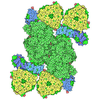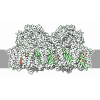[English] 日本語
 Yorodumi
Yorodumi- PDB-5xnm: Structure of unstacked C2S2M2-type PSII-LHCII supercomplex from P... -
+ Open data
Open data
- Basic information
Basic information
| Entry | Database: PDB / ID: 5xnm | |||||||||||||||
|---|---|---|---|---|---|---|---|---|---|---|---|---|---|---|---|---|
| Title | Structure of unstacked C2S2M2-type PSII-LHCII supercomplex from Pisum sativum | |||||||||||||||
 Components Components |
| |||||||||||||||
 Keywords Keywords | MEMBRANE PROTEIN / Photosystem II / PSII-LHCII / C2S2M2 / Supercomplex | |||||||||||||||
| Function / homology |  Function and homology information Function and homology informationphotosynthesis, light harvesting in photosystem II / PSII associated light-harvesting complex II / response to high light intensity / plastoglobule / regulation of stomatal movement / response to abscisic acid / photosynthesis, light harvesting / photosynthesis, light harvesting in photosystem I / photosystem II oxygen evolving complex / photosystem II assembly ...photosynthesis, light harvesting in photosystem II / PSII associated light-harvesting complex II / response to high light intensity / plastoglobule / regulation of stomatal movement / response to abscisic acid / photosynthesis, light harvesting / photosynthesis, light harvesting in photosystem I / photosystem II oxygen evolving complex / photosystem II assembly / oxygen evolving activity / photosystem II stabilization / photosystem II reaction center / photosystem II / chloroplast envelope / oxidoreductase activity, acting on diphenols and related substances as donors, oxygen as acceptor / photosystem I / photosynthetic electron transport chain / response to herbicide / photosystem II / photosynthesis, light reaction / chloroplast thylakoid membrane / phosphate ion binding / photosynthetic electron transport in photosystem II / chlorophyll binding / electron transporter, transferring electrons within the cyclic electron transport pathway of photosynthesis activity / response to light stimulus / photosynthesis / electron transfer activity / protein stabilization / iron ion binding / protein domain specific binding / heme binding / metal ion binding Similarity search - Function | |||||||||||||||
| Biological species |  | |||||||||||||||
| Method | ELECTRON MICROSCOPY / single particle reconstruction / cryo EM / Resolution: 3.2 Å | |||||||||||||||
 Authors Authors | Su, X.D. / Ma, J. / Wei, X.P. / Cao, P. / Zhu, D.J. / Chang, W.R. / Liu, Z.F. / Zhang, X.Z. / Li, M. | |||||||||||||||
| Funding support |  China, 4items China, 4items
| |||||||||||||||
 Citation Citation |  Journal: Science / Year: 2017 Journal: Science / Year: 2017Title: Structure and assembly mechanism of plant CSM-type PSII-LHCII supercomplex. Authors: Xiaodong Su / Jun Ma / Xuepeng Wei / Peng Cao / Dongjie Zhu / Wenrui Chang / Zhenfeng Liu / Xinzheng Zhang / Mei Li /  Abstract: In plants, the photosynthetic machinery photosystem II (PSII) consists of a core complex associated with variable numbers of light-harvesting complexes II (LHCIIs). The supercomplex, comprising a ...In plants, the photosynthetic machinery photosystem II (PSII) consists of a core complex associated with variable numbers of light-harvesting complexes II (LHCIIs). The supercomplex, comprising a dimeric core and two strongly bound and two moderately bound LHCIIs (CSM), is the dominant form in plants acclimated to limited light. Here we report cryo-electron microscopy structures of two forms of CSM (termed stacked and unstacked) from at 2.7- and 3.2-angstrom resolution, respectively. In each CSM, the moderately bound LHCII assembles specifically with a peripheral antenna complex CP24-CP29 heterodimer and the strongly bound LHCII, to establish a pigment network that facilitates light harvesting at the periphery and energy transfer into the core. The high mobility of peripheral antennae, including the moderately bound LHCII and CP24, provides insights into functional regulation of plant PSII. | |||||||||||||||
| History |
|
- Structure visualization
Structure visualization
| Movie |
 Movie viewer Movie viewer |
|---|---|
| Structure viewer | Molecule:  Molmil Molmil Jmol/JSmol Jmol/JSmol |
- Downloads & links
Downloads & links
- Download
Download
| PDBx/mmCIF format |  5xnm.cif.gz 5xnm.cif.gz | 2.3 MB | Display |  PDBx/mmCIF format PDBx/mmCIF format |
|---|---|---|---|---|
| PDB format |  pdb5xnm.ent.gz pdb5xnm.ent.gz | 2 MB | Display |  PDB format PDB format |
| PDBx/mmJSON format |  5xnm.json.gz 5xnm.json.gz | Tree view |  PDBx/mmJSON format PDBx/mmJSON format | |
| Others |  Other downloads Other downloads |
-Validation report
| Arichive directory |  https://data.pdbj.org/pub/pdb/validation_reports/xn/5xnm https://data.pdbj.org/pub/pdb/validation_reports/xn/5xnm ftp://data.pdbj.org/pub/pdb/validation_reports/xn/5xnm ftp://data.pdbj.org/pub/pdb/validation_reports/xn/5xnm | HTTPS FTP |
|---|
-Related structure data
| Related structure data |  6742MC  6741C  6743C  6744C  5xnlC  5xnnC  5xnoC M: map data used to model this data C: citing same article ( |
|---|---|
| Similar structure data |
- Links
Links
- Assembly
Assembly
| Deposited unit | 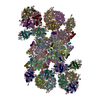
|
|---|---|
| 1 |
|
- Components
Components
-Chlorophyll a-b binding ... , 2 types, 12 molecules 12GNY56gny37
| #1: Protein | Mass: 24952.113 Da / Num. of mol.: 10 / Fragment: UNP residues 23-265 / Source method: isolated from a natural source / Source: (natural)  #2: Protein | Mass: 26545.240 Da / Num. of mol.: 2 / Fragment: UNP residues 23-265 / Source method: isolated from a natural source / Source: (natural)  |
|---|
-Light harvesting chlorophyll a/b-binding protein ... , 3 types, 6 molecules 48RrSs
| #3: Protein | Mass: 22858.957 Da / Num. of mol.: 2 / Source method: isolated from a natural source / Source: (natural)  #17: Protein | Mass: 27138.688 Da / Num. of mol.: 2 / Source method: isolated from a natural source / Source: (natural)  #18: Protein | Mass: 26541.545 Da / Num. of mol.: 2 / Source method: isolated from a natural source / Source: (natural)  |
|---|
-Photosystem II ... , 15 types, 30 molecules AaBbCcDdHhIiJjKkLlMmTtUuWwXxZz
| #4: Protein | Mass: 38147.430 Da / Num. of mol.: 2 / Source method: isolated from a natural source / Source: (natural)  #5: Protein | Mass: 56117.840 Da / Num. of mol.: 2 / Source method: isolated from a natural source / Source: (natural)  #6: Protein | Mass: 52035.629 Da / Num. of mol.: 2 / Source method: isolated from a natural source / Source: (natural)  #7: Protein | Mass: 39557.199 Da / Num. of mol.: 2 / Source method: isolated from a natural source / Source: (natural)  #10: Protein | Mass: 7863.094 Da / Num. of mol.: 2 / Source method: isolated from a natural source / Source: (natural)  #11: Protein/peptide | Mass: 4184.918 Da / Num. of mol.: 2 / Source method: isolated from a natural source / Source: (natural)  #12: Protein/peptide | Mass: 4116.847 Da / Num. of mol.: 2 / Source method: isolated from a natural source / Source: (natural)  #13: Protein | Mass: 6912.290 Da / Num. of mol.: 2 / Source method: isolated from a natural source / Source: (natural)  #14: Protein/peptide | Mass: 4498.100 Da / Num. of mol.: 2 / Source method: isolated from a natural source / Source: (natural)  #15: Protein/peptide | Mass: 3756.513 Da / Num. of mol.: 2 / Source method: isolated from a natural source / Source: (natural)  #19: Protein/peptide | Mass: 4036.859 Da / Num. of mol.: 2 / Source method: isolated from a natural source / Source: (natural)  #20: Protein | Mass: 10676.572 Da / Num. of mol.: 2 / Source method: isolated from a natural source / Source: (natural)  #21: Protein | Mass: 5914.629 Da / Num. of mol.: 2 / Source method: isolated from a natural source / Source: (natural)  #22: Protein | Mass: 8692.072 Da / Num. of mol.: 2 / Source method: isolated from a natural source / Source: (natural)  #23: Protein | Mass: 6555.742 Da / Num. of mol.: 2 / Source method: isolated from a natural source / Source: (natural)  |
|---|
-Cytochrome b559 subunit ... , 2 types, 4 molecules EeFf
| #8: Protein | Mass: 9421.555 Da / Num. of mol.: 2 / Source method: isolated from a natural source / Source: (natural)  #9: Protein/peptide | Mass: 4488.324 Da / Num. of mol.: 2 / Source method: isolated from a natural source / Source: (natural)  |
|---|
-Protein / Sugars , 2 types, 12 molecules Oo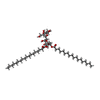

| #16: Protein | Mass: 26554.646 Da / Num. of mol.: 2 / Fragment: UNP residues 82-329 / Source method: isolated from a natural source / Source: (natural)  #37: Sugar | ChemComp-DGD / |
|---|
-Non-polymers , 15 types, 476 molecules 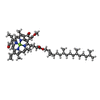
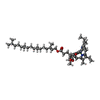
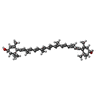
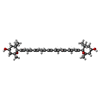
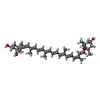
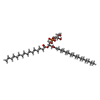
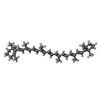



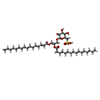
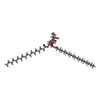
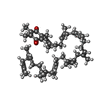
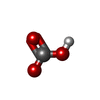















| #24: Chemical | ChemComp-CHL / #25: Chemical | ChemComp-CLA / #26: Chemical | ChemComp-LUT / ( #27: Chemical | ChemComp-XAT / ( #28: Chemical | ChemComp-NEX / ( #29: Chemical | ChemComp-LHG / #30: Chemical | ChemComp-BCR / #31: Chemical | #32: Chemical | #33: Chemical | ChemComp-PHO / #34: Chemical | ChemComp-SQD / #35: Chemical | ChemComp-LMG / #36: Chemical | ChemComp-PL9 / |
|---|
 Movie
Movie Controller
Controller


 UCSF Chimera
UCSF Chimera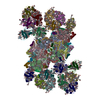

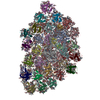

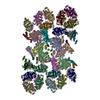

 PDBj
PDBj